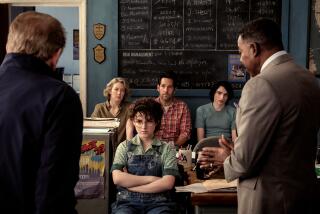How the ‘Child’s Play’ remake redesigned Chucky, a smart doll with a killer glitch
Tasked with re-imagining the pint-sized killer doll Chucky, one of the most iconic villains in the horror canon, “Child’s Play” reboot helmer Lars Klevberg (“Polaroid”) found inspiration from an unlikely source: adorable, innocent babies.
More specifically, toddlers — including his own — and the ways in which they soak up everything around them both good and bad.
In Orion Pictures’ “Child’s Play,” a remake of the 1988 cult classic that takes a sharp canonical detour away from the original reincarnated serial killer premise, Chucky is a self-learning AI who picks up sociopathic social cues from the humans around him. The R-rated results are both inventive and grisly. Very grisly.
Thirty-one years ago in the film that spawned a franchise of “Child’s Play” theatrical and direct-to-video sequels, screenwriter Don Mancini (with John Lafia and director Tom Holland) introduced Chucky as the embodiment of notorious killer Charles Lee Ray, who uses voodoo to transmit his soul into the body of a doll and wreaks bloody havoc across Chicago.
In this version, the murder and mayhem is not entirely Chucky’s fault. He is man-made, after all.
Part of a line of interactive “Buddi” dolls mass-manufactured by ubiquitous conglomerate Kaslan Corp. with the capability to connect to your electronic devices, this Chucky is a defective, obsolete model that single mom Karen Barclay (Aubrey Plaza) gifts to her 13-year-old son Andy (Gabriel Bateman) for his birthday.
But Andy’s a little too old to be toting a doll around; he quickly loses interest, throwing Chucky into a spiral of existential despair. As Chucky’s weekend box office rivals Buzz Lightyear and Woody well know, neglect can be a hell of a motivator.
With his violence inhibitors set to “off” by a disgruntled factory worker — raising the question of why he was programmed to have any in the first place — the casual violence he observes in the world around him jump-starts his rampage.
“For me, he was like this toddler, this small kid looking at the world for the very first time,” said Klevberg, who had references from Mary Shelley’s “Frankenstein” to “Pinocchio” in mind as he translated Tyler Burton Smith’s script to the screen.
“I wanted to create something that had its own will,” he added, “based on how small toddlers problem-solve and are always curious — initially they have a good heart, and everything they look at and touch is based on a curiosity for what’s going on in the world.”
That curiosity — along with a sense of needfulness, despair and eventual homicidal rage — plays out across Chucky’s freckled face, brought to life by award-winning character FX studio MastersFX. The array of practical animatronic puppets later was enhanced with VFX by Pixomondo.
“I was around when the first [“Child’s Play”] was made, and I remember all the guys that were on that show and I know its construction intimately,” said Emmy-winning artist and MastersFX President Todd Masters. “Kevin Yagher, who supervised the original, is a genius. So to me it meant respecting that work and the art that went into that. But I didn’t want to mimic it or repeat it because, hats off, they did great work, and why repeat it?”
(In the Summer of Evil Dolls, which also includes next week’s “Annabelle Comes Home,” MastersFX is additionally behind the doll design of July’s “Brahms: The Boy II.”)
Although designed largely in tribute to the original film’s villainous Good Guys doll, down to the striped shirt and denim overalls, red hair and mass-produced packaging, the new Chucky’s facial features required an expressive range of emotions to convey different compulsions than the original Chucky.
“Lars is a new dad,” said Masters. “He was really curious about how his own children were giving impressions to him and how curious they were. And if we truly were going to have this machine-learning character that was up to date with AI, they would, very much like a young child, take on a lesson and learn from us — for better or worse.
“I thought that was such a great part of the story,” he said, laughing. “This is how it works, people! Your children are duplications of your bad self!”
Masters and his team worked out of their Vancouver outpost off initial designs by Klevberg and designer Einar Martinsen to build a small army of half a dozen foam latex Chuckys with interchangeable heads, hands and motor-filled animatronic bodies made of plastic and aluminum. They were then brought to life on the Vancouver set by a team of puppeteers. One model entirely operated by remote control was dubbed “RoboChucky.”
Like the Kaslan Corp. merchandise that saturates the world of “Child’s Play,” the Buddi product design was partly inspired by the corporate sensibility of the Starbucks logo, said Masters. With Chucky’s “emotions” centering his actions, the filmmakers needed to strike a balance between factory-line parts and his eerily human-like qualities.
After all, the eyes are the windows to the soul, and Chucky’s wide blue eyes turn maniacal red when he’s in murder mode. The trickiest part of Chucky’s new design? Those eyebrows.
“It was a great dilemma,” said Masters, whose team spent weeks testing different brow shapes and materials for Chucky. “And then we looked at one of our artists’ eyebrows. I think she has a little liner in there, but they’re beautifully styled. I asked if she could do a version of the eyebrows just like her own. … It’s one of those details that, on everything, we really suffer through; eyebrows can really make or break a character.”
Subtle details like that lend more emotional nonverbal qualities to Chucky’s design, according to the filmmakers. In a nod to the original film, as Chucky becomes more deranged, his hairline recedes, Klevberg said. “He starts to get a little more humanoid and scary.”

Chucky may be mimicking the humans around him by observing and absorbing far more than anyone realizes — from the way Andy stabs a sandwich to the glee his teenage pals find in watching 1986’s “The Texas Chainsaw Massacre 2.” But his motivation is SkyNet-adjacent.
“All self-aware creatures — what they ask themselves is ‘What is my purpose? What is my role in all this?’” said Klevberg. “Chucky basically wants to make Andy happy and he wants to be Andy’s friend — his friend for life, until the end. And unfortunately the way he acts to preserve that unfolds in a very gruesome way.
“Chucky believes it’s all very logical. For me, that makes him a very interesting antagonist.”
And one that becomes gradually more self-aware as the film progresses. Voiced by Mark Hamill, the character transforms from blank slate into a vindictive Chucky audiences haven’t seen before. (With franchise rights split between studios, the Charles Lee Ray-version of Chucky lives on at Universal where a spinoff series is in the works.)
That awareness and a winking sense of humor reverberate through the credits in “The Buddi Song,” a ditty sung with creepy flair by Hamill with lyrics by composer Bear McCreary: “You are my buddy, until the end / more than a buddy, you’re my best friend … I’ll be yours ‘til the day that you die.”
It’s a lullaby fit for Chucky 2.0, Klevberg proudly noted. “It’s like a song in a Pixar movie.”
More to Read
Only good movies
Get the Indie Focus newsletter, Mark Olsen's weekly guide to the world of cinema.
You may occasionally receive promotional content from the Los Angeles Times.







